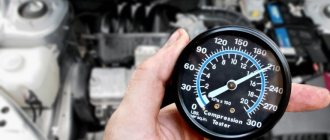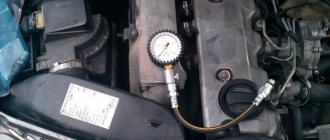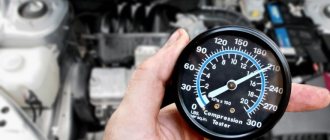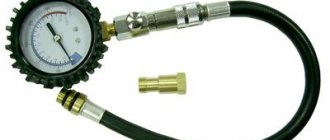02/04/2022 7,783 VAZ 2106
Author: Ivan Baranov
During the operation of a car, sometimes it becomes necessary to measure the compression in the engine cylinders. Typically, such a need arises during diagnostics if there is a suspicion of a malfunction of the piston group. The article discusses what the VAZ 2106 compression is and how it is measured.
[Hide]
Compression measurement in carburetor engine cylinders
The procedure given in the article and recommendations for measuring compression in cylinders are applicable for gasoline carburetor engines of VAZ passenger cars - 2108, 21081, 21083, 2109, 21091, 21099, 2101, 2106, 2105, 2107, 21021, 210213, 1111 and a number of others similar (Moskvich, Izh, Volga...).
Measuring compression on injection engines has a number of features and will be discussed in a separate article. Before tuning and adjusting the carburetor of your car, you should take into account the general condition of the engine, since the symptoms of a number of its malfunctions can be mistakenly considered symptoms of carburetor malfunctions. For example, unstable idling or difficult starting may indicate not only problems in the idle or carburetor starting system, but also that one of the valves in the engine is burnt out, the head gasket is broken, the piston rings are worn out or stuck, etc. By measuring the compression, we will more or less accurately determine the condition of the engine and identify possible malfunctions in its operation. After eliminating them, you can safely adjust the carburetor. Tools and devices for measuring compression
Preparatory work
1. Warm up the engine to operating temperature (80-90º).
2. Remove the fuel supply hose from the fuel pump.
3. We unscrew all the spark plugs, having first cleared their wells of dirt and debris.
4. Remove the central armored wire from the distributor cover, insert the spark plug into it and place it on the engine.
5. Screw the tip of the compression gauge into the hole of the first cylinder, or press it firmly against this hole.
Measuring compression in carburetor engine cylinders
Measuring compression in carburetor engine cylinders
1. An assistant, sitting in the car, presses the gas pedal all the way and, turning the key in the ignition, starts the starter for 3-5 seconds.
2. Observe the compression meter readings, record the dynamics of their growth and the maximum value. After fixing, release the pressure in the device by pressing the reset button.
3. We repeat the operation for each cylinder, recording or remembering the measured readings.
Analysis of compression meter readings
— Excellent pressure (compression) – 12-13 kg/cm 2 (1.2-1.3 MPa)
— Normal pressure – 10-11 kg/cm 2 (1.0-1.1 MPa)
- Repair needed - 8-9 kg/cm 2 (0.8-0.9 MPa)
For an extended analysis of the compression meter readings after a compression measurement, see “Analysis and interpretation of the compression meter readings.” After the analysis, you can independently, with a high degree of accuracy, determine the malfunction of the rings, pistons, cylinders and valves of the engine.
Notes and additions
Factors influencing inaccuracy in compression measurements
The compression gauge readings will be lower if:
— Low battery charge.
— The valve clearances are not adjusted.
— Gasoline getting into the cylinders.
— Carrying out measurements without pressing the gas pedal.
The compression gauge readings will be higher if:
— Excess oil enters the engine cylinders due to wear of the valve stem seals, valve guides or CPG.
Determining the causes of low compression in engine cylinders using compressed air
We determine the compression stroke in the desired cylinder. Insert a thin long screwdriver (a wooden stick, a piece of wire...) into the spark plug hole of the desired cylinder and hold it with your hand, resting it on the bottom of the piston. We turn the crankshaft using the ratchet (on engines 2101-2107) or using a large slotted screwdriver using the flywheel teeth in the hatch on the clutch housing (2108...). When the piston moves upward (compression stroke), the screwdriver will come out of the spark plug hole, supported from below by the piston. It is necessary to catch the moment when it stops moving up and starts moving down following the outgoing piston (intake stroke). This moment will be the top dead center when the piston moves, the end of the compression stroke.
We insert the compressor hose into the spark plug hole and supply compressed air to the cylinder under a pressure of 2-3 atmospheres. Based on where it will come from, we determine the malfunction.
1. From the adjacent spark plug hole or into the expansion tank (boiling) - the head gasket has burned out.
2. From the carburetor - the intake valve is burnt out or the valves are not adjusted.
3. From the muffler - the exhaust valve is burnt out or the valves are also not adjusted.
4. From the breather - the rings are worn out, the pistons are burnt out.
Determining the causes of low compression using engine oil
Pour 10 cubes of engine oil into the cylinder and measure the compression again. The compression gauge readings have increased - the rings are faulty or stuck, the cylinder-piston group is worn out, but remain the same - the valve or head gasket has burned out.
Recommendations
It’s just the Chinese crap that’s overpricing. 16 is the wrong number
Engine compression and compression ratio. What it is?
Compression is the maximum air pressure in the combustion chamber at the end of the compression stroke. The engine compression ratio is the ratio of the total volume of the cylinder to the volume of the combustion chamber. Compression ratio. On a forced engine, depending on the final task, the compression ratio can vary significantly, reaching values of 11 - 11.5. All this is aimed at extracting maximum power from a motor of a specific size. The higher the compression ratio, the higher the power density. True, this will inevitably reduce the service life and sharply increase the risk of problems with the engine when refueling with low-quality fuel. One refueling with questionable fuel can quickly kill a “stressed” engine. So, when boosting the engine, it will not be possible to save on the quality of gasoline. Therefore, when tuning the engine, the compression ratio does not increase very significantly, usually in order to switch to a brand of gasoline that is next to the one already used in terms of octane number. In principle, indirectly, the value of the compression ratio can be judged by the brand of gasoline used - you can drive an AI-80 with a compression ratio of 9.0, and an AI-92 - up to 10.0 (provided that the gasoline meets the declared characteristics). Increasing the compression ratio - a complex process that requires precise calculations and very highly qualified mechanics. Therefore, it is highly not recommended to do this yourself. Compression. As mentioned above, compression is the pressure in the cylinder. This is why compression depends on the compression ratio (the pressure in a smaller volume will always be greater, i.e., as the compression ratio increases, the compression increases). By the amount of compression you can preliminarily judge the condition of the engine.
It is important to carry out the compression measurement procedure correctly. To do this you need: the engine is warmed up, the battery is fully charged, the throttle is open, the air filter is removed, all spark plugs are unscrewed
In this mode, a fully charged battery will allow the starter to spin the engine up to 200 rpm. Compression in all cylinders should be equal. If the compression level decreases, it is necessary to find out the cause of the drop. It could be piston rings or problems in the valve mechanism, you can find out this way. 15-20 grams are injected into the problematic cylinders using a syringe. motor oil. The measurement procedure is repeated. If the pressure gauge readings have increased, the reason for the drop is in the piston rings; if they remain at the same level, it is in the valves.
Go herd the geese, you see he is silent, he has already measured the COMPRESSION, but the degree of compression is not measured, it is CALCULATED!
I taught Pallas's cat that compression and compression ratio are two different things, but we measure compression, and compression ratio is always higher than compression, STUDENT!
What are you talking about?
You got it wrong, if the compression is 11 then the compression ratio is 18, take the manul to school, September 1 is not far away.
There is a conversation, what amperage do you have on the Prior? And look, which one has a diesel engine, so you lamented, and I don’t need to go anywhere, I’m speaking after the fact. A long time ago there was a V8 belt with a 1.3 engine, I installed the piston from the V, and what happened was that everything was fine when it was cold, but when the engine was hot it wouldn’t start, the starter just wouldn’t crank. I measured the compression in the first 15 in the remaining 14, I had to remove the head and put on another gasket, and it became normal everywhere 12 and still drives like that. So throw away this compression gauge, Chinese antlers are not known for the boys who don’t understand anything
And where have you seen a diesel engine, it’s only started from the launcher? And the physics of diesel ignition is a high compression ratio, so don’t bother me, I repair engines, both diesel and gasoline, and I understand a lot. And for example, look under the hood of a Mitsibisi El 200, and you will see 2, I repeat 2, batteries to start the engine.
In short, I’ll replace it with an expensive compression meter in the near future0
gee gee! do you have a diesel engine? In general, if the compression is above thirteen, then something is wrong in the engine. and when it’s hot it’s unlikely to start at 16, the starter won’t crank
Post a video? everything starts up fine
gee gee! do you have a diesel engine? In general, if the compression is above thirteen, then something is wrong in the engine. and when it’s hot it’s unlikely to start at 16, the starter won’t crank
Diesel has at least 23
Naive, I will never believe that there is such compression, because I repair engines.
Source
Checking engine compression
Calculator for converting pressure in bar to MPa, kgf and psi
Online converter to convert pressure in megapascals (mPa) to kilograms (kgf cm2), bar, pound force (psi) and atmosphere
An engine compression test is performed to find faults in an internal combustion engine. Compression is the compression of the mixture in the cylinder under the influence of external forces. It is measured as the compression ratio multiplied by 1.3. When measuring compression, you can find a cylinder that is malfunctioning .
If the car has various kinds of problems, such as a drop in power, loss of oil, friction in the engine, then check the spark plugs, sensors, and inspect the engine for damage and leaks. When such checks do not bring results, then they resort to measuring compression. How to determine it using the example of a VAZ classic is shown in this video.
yourself using a compression gauge . At service stations, such checks are done using a compressor or motor tester.
Why check
It is recommended to check the compression on the VAZ 2110 regularly to prevent possible malfunctions and problems with the engine.
Measurements are taken with the throttle valve open and closed. Each test option gives its own results and data on the condition of the engine.
Checking with the valve open allows you to determine:
If you check the compression with the throttle closed, you can find out:
Methods
There are two main ways in which you can check the compression readings in the engine.
Way
Peculiarities
Using measuring instruments
Effective, gives the most accurate results. But it requires special measuring instruments - a pressure gauge or compression gauge. Applicable in 90% of cases
Manual verification method
Difficult to perform because it requires unscrewing the spark plug from each cylinder and cranking the crankshaft. A problematic cylinder can be determined by the effort that has to be applied when turning. Efficiency is not high
Considering the possible results of the test, it is recommended to always check the compression only with measuring instruments and do this at least once every 3-4 months, as well as if there is a suspicion of unstable engine operation.
How to measure engine compression
First you need to prepare the engine for testing. To do this, we need to warm up the engine to a high temperature of 70-90 degrees. After this, you need to turn off the fuel pump so that no fuel is supplied and remove the spark plugs.
After all this, we move on to checking the compression :
- We insert the tip of the compression gauge into the spark plug connector and use the starter to crank the engine until the pressure stops increasing.
- The crankshaft should rotate at about 200 rpm.
- If the engine is working properly, then compression should increase in a matter of seconds . If this happens for a long time, the piston rings will burn out. If the pressure does not increase at all, then most likely the block gasket needs to be changed. The minimum pressure in a gasoline engine should be from 10 kg/cm² (in a diesel engine more than 20 kg/cm²).
- After taking readings, release the pressure by unscrewing the cap on the device.
- Check all other cylinders in the same way.
Illustration of the stages of measuring compression in a cylinder
There is another method of checking, which differs from the above in that engine oil is poured into the cylinder being tested. An increase in pressure indicates worn out piston rings; if the pressure does not increase, then the reason is the cylinder head gasket , or there is a leak in the valves.
Weak compression can also be diagnosed by malfunctions in the carburetor. If there is an air leak, check the fit of the bypass valve. If air leaks out of the top of the radiator, then a faulty cylinder head is to blame.
Why measure compression?
It makes sense to measure compression when you notice one of the following symptoms:
- reduction in engine power (reduced traction, increased acceleration time);
- increased oil consumption;
- interruptions in engine operation (if replacing spark plugs and checking the coils did not yield anything);
- increased fuel consumption.
The nominal compression value in a particular engine design is influenced by a variety of factors, so check the exact value and permissible deviations in the repair manual for your car.
Measuring the compression in the cylinders will help to identify the malfunction in a timely manner.
What affects engine compression
- Throttle position . When the throttle is closed or covered, the pressure decreases
- Air filter dirty.
- Incorrect valve timing when the valve closes and opens at the wrong times. This happens when the belt or chain is installed incorrectly.
- The valves do not close on time due to gaps in their drive.
- Motor temperature . The higher its temperature, the higher the temperature of the mixture. Therefore, the pressure is lower.
- Air leak . Air leaks reduce compression. They are caused by damage or natural wear of the combustion chamber seals.
- Oil entering the combustion chamber increases compression.
- If fuel enters in the form of droplets , then compression is reduced - the oil, which plays the role of a sealant, is washed off.
- Lack of tightness in the compression gauge or check valve.
- Crankshaft rotation speed . The higher it is, the higher the compression; there will be no leaks due to depressurization.
Signs of low compression and how to measure it on a VAZ engine
Compression on a VAZ 2114 should be measured every 30 thousand kilometers. This is usually done in conjunction with adjusting the valves. However, signs of low compression may not only appear with a routine check. As you use your car, signs of poor compression are easy to spot; you just need to keep a close eye on your engine. These are phenomena such as:
- ICE strength drops sharply;
- the engine fires, this can happen when low compression occurs in one cylinder;
- significantly increases oil and gasoline consumption.
Measuring compression in a diesel engine
- In order to turn off the flow of diesel into the engine, you need to disconnect the fuel supply valve from the power supply. This can also be done by clamping the shut-off lever on the high pressure pump.
- Measurements on a diesel engine are made with a special compression meter, which has its own characteristics.
- When checking, you do not need to press the gas pedal, since such internal combustion engines do not have a throttle. If there is one, it must be cleaned before checking.
- Each type of engine is supplied with special instructions on how to measure compression on it.
Compression test on a diesel engine.
Compression measurement on an injection car
It is worth remembering that compression measurements can be inaccurate. For the most part, measurements need to take into account the pressure difference between the cylinders, and not the average compression value.
You should definitely take into account such parameters as oil, engine, air temperature, engine rotation speed, etc. Only taking into account all the parameters can one draw a conclusion about the degree of wear of the pistons and other parts that affect compression. And as a result of all these malfunctions, give a conclusion about the need for a major overhaul of the engine.
How to check compression without a compression gauge
Without a device you won't be able to measure compression. Because the word “measurement” itself implies the use of a measuring device. So it is impossible to measure compression in an engine without a compression gauge . But if you need to check to determine whether it exists at all (for example, after a broken timing belt or a long period of inactivity of the car, etc.), then there are several simple ways to check compression without a compression gauge. A sign of poor compression is the atypical behavior of the car, when, for example, at low speeds it works sluggishly and unsteadily, and at high speeds it “wakes up”, while their exhaust smoke is bluish, and if you look at the spark plugs, they will be in oil. As compression decreases, the pressure of crankcase gases increases, the ventilation system becomes dirty faster and, as a result, CO toxicity increases and combustion chamber contamination increases.
Checking compression without instruments
The most basic way to check engine compression without instruments is by ear . So, as usual, if there is compression in the engine cylinders, then by rotating the starter you can hear how the engine works out each compression stroke with a characteristic sound. Moreover, in most cases the engine may sway a little. When there is no compression, then neither clear beats will be heard, nor will there be any trembling. This behavior often indicates a broken timing belt.
Video on how to check engine compression without instruments
By plugging the spark plug well with a plug of a suitable diameter (rubber, cortical plastic or thick rag) , and first unscrewing the spark plug of one of the cylinders, you can check if there is at least some compression. After all, if it is there, the cork will fly out with a characteristic pop. If there is no compression, it will remain where it was.
The applied force when turning the HF . This method of checking compression has no accuracy at all, but, nevertheless, people sometimes use it. You need to unscrew all the spark plugs, except for the first cylinder, and turn them by hand using the crankshaft pulley bolt until the compression stroke ends (determined by the timing marks). Next, we repeat the same procedure with all other cylinders, approximately remembering the applied force. Since the measurements are rather arbitrary, it is preferable to use a compression meter. Every car owner should have such a device, because its price is so high that it is not worth buying, and its help may be needed at any time. You can find out the required compression value for your car from the service manual, or at least find out the compression ratio of your car's engine, then the compression can be calculated using the formula: compression ratio * K (where K = 1.3 for gasoline and 1.3-1, 7 for diesel internal combustion engines).
Based on the condition of the exhaust or the condition of the spark plugs , only an experienced mechanic can determine the compression without a device, and then the same thing is relative.
Diagnosing faults
After taking measurements in all cylinders, you should pay attention to two points. The first is whether the measured compression corresponds to the minimum permissible value
The first is whether the measured compression corresponds to the minimum permissible value.
It is determined by the engine developers and is indicated in the repair manual.
The second is the difference in compression values in different cylinders of the same engine.
As a rule, it should not exceed 20% of the nominal value.
If you find that the pressure in any of the cylinders is below normal, inject three portions of oil into it from a manual oil can.
Do not inject more than three portions of oil, as excess oil can lead to the formation of a hydrostatic plug, which can cause breakage of the rings, piston, or even lead to a crack in the cylinder head.
The oil will seal the gap between the rings and the cylinder, and if the reason for the low compression was in this gap, then with such a “wet” test the compression should increase significantly.
Then check the condition of the rings, and if one of them is damaged or stuck, replace it.
If compression behaves this way in all cylinders, then it’s probably time for a serious repair with boring the cylinders and installing rings of the next repair size.
The effect of additives that increase compression is based on the effect of sealing gaps, similar to an oil wedge.
This is the easiest way to restore to some extent the former agility of the engine.
Only in this case you need to remember that their effect is quite short-lived, and repeated use no longer has such an effect.
Therefore, this method is often used before selling a car, so as not to spend money on expensive engine repairs.
If, after injecting oil into the cylinder, the compression changes slightly, then most likely the reason for its drop is a malfunction of the valve group or a broken cylinder head gasket.
From all that has been said, another conclusion follows: low, but approximately equal in all cylinders, compression indicates natural wear of engine parts, but a sharply different drop in one or more cylinders indicates a malfunction.
Sometimes damage or wear to the oil ring can cause compression to rise above the values set for a new engine.
This occurs because the worn ring does not remove excess oil from the cylinder walls, and it seals the gap between the cylinder and the compression rings, and then, during the power stroke of the piston, the oil burns out, forming carbon deposits on the cylinder head.
If this process continues for a long time, then the carbon layer becomes so significant that it leads to a decrease in the volume of the combustion chamber, and therefore to an increase in compression.
This phenomenon is dangerous due to engine detonation. It also leads to increased oil consumption.
Video: measuring compression correctly
Compression is an important indicator of engine health. If it is normal, then we can speak with confidence about the serviceability of its main parts: the cylinder head, cylinders, pistons, piston rings and valve group.
If the measured compression values differ from the values permissible by the engine manufacturer, then this is a reason to quickly determine and eliminate the cause of the malfunction.
Compression measurement results
The results of compression measurements show the condition of the engine, in particular the pistons, piston rings, valves, camshafts, and allow decisions to be made about the need for repair or just replacement of the head gasket or valve stem seals.
On gasoline engines, normal compression is in the range of 12-15 bar. If we take a closer look, the trend will be as follows:
- front-wheel drive domestic cars and old foreign cars - 13.5-14 bar;
- rear-wheel drive carburetor – up to 11-12;
- new foreign cars are 13.7-16 bar, and turbocharged cars and with a large volume up to 18 bar.
- in the cylinders of a diesel car, the compression should be at least 25-40 atm.
The table below shows more accurate compression pressure values for different engines:
| engine's type | Value, bar | Wear limit, bar |
| 1.6, 2.0 l | 10,0 — 13,0 | 7,0 |
| 1.8 l | 9,0 — 14,0 | 7,5 |
| 3.0, 4.2 l | 10,0 — 14,0 | 9,0 |
| 1.9 L TDI | 25,0 — 31,0 | 19,0 |
| 2.5 l TDI | 24,0 — 33,0 | 24,0 |











